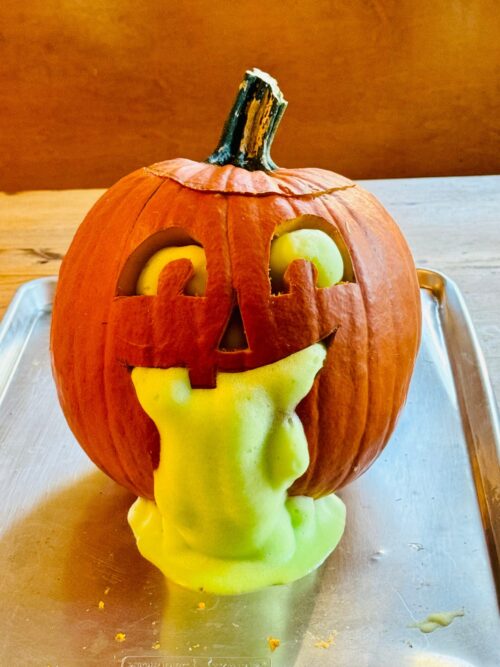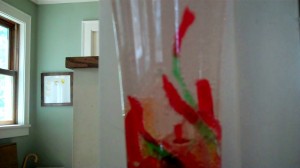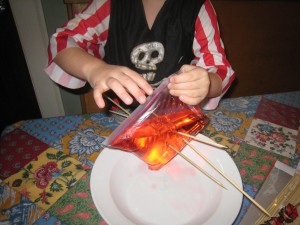Tag: Halloween Science’
Oozing Halloween Pumpkins
- by KitchenPantryScientist
Use hydrogen peroxide, dish soap and dry yeast to make a Jack-O-Lantern ooze beautiful green bubbles! (*Don’t forget the safety goggles. Adult supervision required)
Click here to watch the chemical reaction in action!

Ingredients:
-large bottle of 6, 10 or 12% hydrogen peroxide, or 20, 30 or 40 volume hydrogen peroxide clear developer (found at beauty supply shops or online.) * note: concentrated hydrogen peroxide can burn eyes and damage clothing
-Jack-O-lantern with top
-dish soap
-food coloring
-water
-dry yeast
-jar that will fit inside pumpkin
-Large rimmed baking sheet or tray to contain the mess
-safety goggles
Instructions:
- Add a few tablespoons of water, 3 Tbsp. dish soap and a tsp. green food coloring to the jar. Mix well.
- Put the pumpkin on the tray and the jar in the pumpkin. Carefully add 1 cup of hydrogen peroxide to the dish soap mixture in the jar. Stir to mix.
- In a separate container, mix 3 teaspoons yeast with 1/4 cup warm (not hot) water. Mix well.
- To start the chemical reaction, quickly pour all of the yeast mixture into the hydrogen peroxide and immediately put the top on the pumpkin.
- Watch the chemical reaction happen.
The Science Behind the Fun
A chemical scissors (an enzyme called catalase) in the yeast breaks hydrogen peroxide (H2O2) into water (H20) and Oxygen (O), making lots of bubbles in the soap. The reaction feels warms because it releases energy. Reactions that give off heat are called exothermic reactions.
Halloween Science: Non-Toxic Fake Blood
- by KitchenPantryScientist
Unlike the foaming green alien blood in the X-Files, the blood pulsing through our veins is red, thanks to iron-containing hemoglobin molecules loaded with life-giving oxygen.

fake blood
To make fake blood that looks like real blood, you’ll need to concoct a mixture of liquid, thickeners and red pigment (tinted with blue and brown.) Kids will have a great time coming up with their own concoctions. Have a creative chemistry contest to see who can come up with the most realistic fake blood, or use it to make scary Halloween props.

Here’s a recipe to start with, but kids can work with smaller amounts and mix their blood in bowls, rather than a blender. Fake blood stains everything it touches, so be prepared for messy hands and wear old clothes! Naturally red plant pigments, like the ones in pomegranate juice and raspberry jam won’t stain fingers as much as food coloring and taste yummy. However, red food coloring will give you a more realistic color.
Blend together:
1/3 cup pomegranate juice (like POM) or fruit punch
2 Tbs corn starch
1 Tbs chocolate syrup (or 1 Tbs cocoa powder)
1 Tbs red food coloring
1 cup corn syrup
Tint with a tiny bit of blue food coloring. (optional)
Other ingredients to try: seedless raspberry jam, cocoa powder, Kool-Aid, Jell-O, flour, maple syrup
Here’s a fun TV segment where meteorologist Matt Brinkman was game enough to try out one of the blood capsules we made!
We made the edible blood capsules you see in the video by filling empty gelatin and vegetarian capsules with a mix of raspberry jelly, corn syrup and chocolate syrup.
Halloween Science: Frankenworms
- by KitchenPantryScientist
A chemical reaction happens when you mix two or more things together to make something new.
Mixing sodium bicarbonate (baking soda) and acetic acid (vinegar) together produces carbon dioxide gas bubbles, which can make gummy worms which have been cut into very thin strips squirm and float! My kids created this experiment a few years ago! Can you think of an experiment you could do with candy?
To make Frankenworms:
1. Cut gummy worms into skinny, skinny long strips (May require adult assistance. The skinnier they are, the better they’ll work.) *Not all gummy worms are created equal. If your worms aren’t wriggling, dip them in baking soda before putting them in the vinegar!
2. Soak the worms in a bowl of water with a few tablespoons of baking soda mixed in for around 20-30 minutes.
3. Drop the baking-soda infused worms into a large, clear glass or jar full of white vinegar and watch them come to “life.”

Frankenworms
- by KitchenPantryScientist
All you’ll need for this spooktacular experiment that we demonstrated on Kare11, are some gummy worms, scissors, baking soda, vinegar and water.
Cut some gummy worms into extra skinny worms by cutting them the long way with kitchen shears. If it’s too tricky, ask an adult to help with this part. Cut each worm lengthwise at least four times. The skinnier, the better! *Not all gummy worms are created equal. If your worms aren’t wriggling, dip them in baking soda before putting them in the vinegar!
Mix a few Tablespoons of baking soda into a cup or so of water, stir, and put your skinny gummy worms in the cup of baking soda solution. Let them soak for 15 or 20 minutes.
Fill a clear glass or jar up with vinegar. (Be careful not to splash any in your eyes.) When the 15 minutes are up, pull your worms out of the baking soda solution with a fork, and drop them into the glass of vinegar. What happens?
Your worms should start to float and move as the vinegar (acetic acid) reacts with the baking soda (sodium bicarbonate) to form carbon dioxide gas bubbles on the worms. They look like they’re alive and will wriggle until the chemical reaction stops!
More Halloween Science: “Bag of Blood”
- by KitchenPantryScientist
You will be amazed when you fill a plastic zip-lock bag with “blood” and poke sharp skewers through, only to find that the bag doesn’t leak! All you need is a ziplock bag, water, food coloring and wooden skewers. Heavy-duty ziplocks work best! Fill a quart-sized ziplock bag with water, add a few drops of red food-coloring, and seal it. Slowly poke several wooden skewers completely through the bag, from one side to the other, avoiding the part with air in it. See how many you can push through! (Remember to be careful with the sharp points and I’d recommend putting a bowl underneath to collect drops.)
Why doesn’t the bag leak? Plastic is a polymer, made up of long, elastic molecules that form a seal around the spot where the skewer is poking through. In addition, the bag is sealed and contains very little air, so there isn’t much air pressure pushing on the water. If you make a hole in the part of the bag with air in it, all the air around you will push on the liquid and you’ll find that the bag leaks like crazy!
Kitchen Table Halloween Science
- by KitchenPantryScientist
We turned our kitchen into a Halloween science lab this morning for the Fox9 news. The kids had a blast! Here’s one of the segments on how to make “Magic Potion”:
